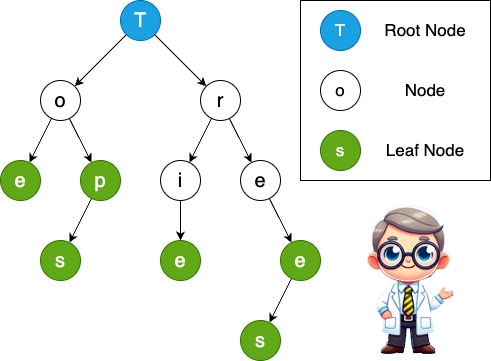Graphs and Tries – From Connections to Clever Text Searching
Graphs and Tries – From Connections to Clever Text Searching
Some data structures are just fun to work with—and this post covers two of our favorites: graphs and tries. Graphs let us represent complex, interconnected systems, while Tries enable lightning-fast word lookups, like auto-complete when typing an email.
What is a Graph?
A graph is a data structure made up of:
- Nodes (or vertices) – individual entities
- Edges – connections between nodes
Types of Graphs
- Directed vs Undirected: Are the edges one-way or two-way?
- Weighted vs Unweighted: Do the edges have a cost or value?
- Cyclic vs Acyclic: Can you loop back to where you started?
Real-World Examples
- Social networks – People (nodes) connected by friendships (edges)
- Google Maps – Intersections (nodes) connected by roads (edges with distance/time)
- Airline routes – Airports connected by direct flights
Graph Algorithms
We’ve already explored how to use graphs to solve powerful problems:
- 📍 Dijkstra’s Algorithm – Finding the shortest path
- 🧭 A* Search – Smarter pathfinding using heuristics
Graphs provide the foundation. Algorithms bring them to life.
Tries (Prefix Trees) – One of Our Favorite Structures!
If you’ve ever typed a few letters into a search box and seen suggestions pop up instantly, chances are you’ve interacted with a Trie.
A Trie is a tree-like data structure that stores words by their prefixes. Instead of storing full words in a list, it breaks them into characters and shares common prefixes to save space and speed up lookups.
Real-World Use Case: Email Auto-Complete
When you start typing ja, your email app suggests:
james@...jane@...jack@...
A Trie makes this easy by storing all email addresses character by character and navigating down matching paths.
Trie Structure Overview

Each node:
- Represents one character
- Has a map of children
- Tracks whether it marks the end of a word
Trie Pseudocode
function insert(word):
current = root
for character in word:
if character not in current.children:
current.children[character] = new TrieNode()
current = current.children[character]
current.is_end_of_word = true
function search(prefix):
current = root
for character in prefix:
if character not in current.children:
return []
current = current.children[character]
return collect_all_words_from(current)
Trie Implementation in C
#include <stdio.h>
#include <stdlib.h>
#include <stdbool.h>
#include <string.h>
#define ALPHABET_SIZE 26
typedef struct TrieNode {
struct TrieNode *children[ALPHABET_SIZE];
bool is_end_of_word;
} TrieNode;
TrieNode* create_node() {
TrieNode* node = (TrieNode*) malloc(sizeof(TrieNode));
node->is_end_of_word = false;
for (int i = 0; i < ALPHABET_SIZE; i++)
node->children[i] = NULL;
return node;
}
void insert(TrieNode* root, const char* word) {
TrieNode* current = root;
while (*word) {
int index = *word - 'a';
if (!current->children[index])
current->children[index] = create_node();
current = current->children[index];
word++;
}
current->is_end_of_word = true;
}
bool search(TrieNode* root, const char* word) {
TrieNode* current = root;
while (*word) {
int index = *word - 'a';
if (!current->children[index]) return false;
current = current->children[index];
word++;
}
return current->is_end_of_word;
}
Performance Characteristics
| Operation | Time Complexity |
|---|---|
| Insert a word | O(m) |
| Search a word | O(m) |
| Space complexity | O(n * m) |
Where:
nis the number of wordsmis the average word length
Tries trade space for speed: they use more memory but give blazingly fast lookup times—perfect for autocomplete, spell checkers, and text indexing.
Challenge Time! 🔍
- Implement a Trie in your language of choice.
- Use it to auto-complete a dictionary of names or cities.
- Bonus: Add support for deleting words from the Trie!
Coming up next: Advanced Structures like Bloom Filters and Fenwick Trees – tools that use clever tricks for probabilistic searches and fast numeric operations.